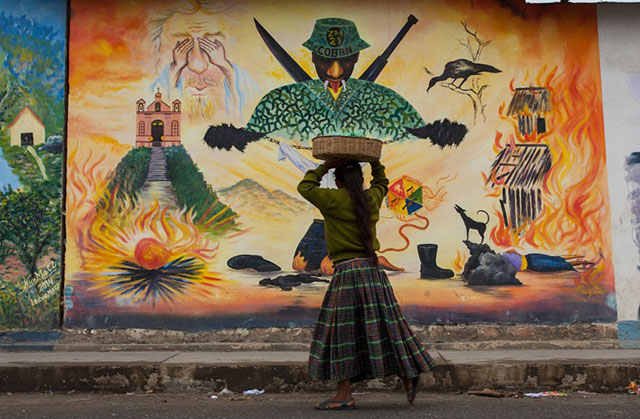
Following the CIA-backed 1954 coup, Guatemala becomes an experimental site for US-sponsored anti-communist tactics that are later used throughout the region under the authority of US-backed right-wing military leaders. Throughout the 1960s & 1970s, Guatemalan right-wing military rulers embark on a systematic campaign targeting “communists” and “communist sympathizers,” as well as political opponents and all those who the government viewed as subversive to their liberal right-wing project.
The agrarian reforms that Arbenz had envisioned would help modernize Guatemala and reduce inequality between the economic/political elite and everyday [indigenous] Guatemalans were cut short by the coup. Thereafter, leftist groups grew increasingly militarized and launched a full scale attack against the right-wing military governments. The indigenous communities that would otherwise have benefitted from Arbenz’ ambitious plans became increasingly disillusioned and turned to the leftist guerrilla groups as a last resort to voice their discontent with the status quo. However, this connection between the indigenous Maya and the leftist guerrillas, “eventually became an idée fixé for the government, who promulgated an ideology that perceived all Maya as natural allies of the insurrection, and thus as enemies of the state. The natural extension of this belief was the deliberate targeting of the civilian population, in order to ‘starve’ guerilla forces of their popular support” (Guatemala), As part of the counter-insurgency tactics employed by Guatemala’s military dictatorships were “disappearances.” Trained by the United States, government death squats kidnapped, interrogated, tortured, and killed political opponents and social activists, dropping their bodies into the pacific or burying them in unmarked graves throughout the Guatemalan countryside with no record of their activities to look back to.

Between 1978 and 1983, violence escalated across the country. First, under the command of “General Fernando  Romeo Lucas García,” extrajudicial killings rose from “100 in 1978 to over 10,000 in 1981” (Guatemala). As a response, a group of Mayan leaders overtook the Spanish Embassy in Guatemala City. Despite pleas from the Spanish government to avoid violence, Guatemalan forces raided the compound. During the raid a fire broke out, resulting in the death of 36 people, including Mayan activists.
Romeo Lucas García,” extrajudicial killings rose from “100 in 1978 to over 10,000 in 1981” (Guatemala). As a response, a group of Mayan leaders overtook the Spanish Embassy in Guatemala City. Despite pleas from the Spanish government to avoid violence, Guatemalan forces raided the compound. During the raid a fire broke out, resulting in the death of 36 people, including Mayan activists.
In 1982, General Efrain Rios Montt replaced Lucas Garcia as head of state and mounted a scorched earth “campaign to wipe out large portions of the country’s indigenous populations” (Guatemala). Rios Montt’s systematic attack of indigenous communities was carried out by the military, para-military groups, and conscripted civilian patrols who targeted over 600 indigenous villages, razing over 300 to the ground. Rapes, torture, and disappearances, were all central to Rios Montt’s terror campaign in the Guatemalan countryside (Guatemala). “Terrorized by the violence, between 500,000 and 1.5 million Mayan civilians fled to other regions within the country or became refugees abroad. Ríos Montt was finally ousted in a coup in 1983. Later, in 1986, a civilian government passed a new constitution and eventually initiated a gradual peace process that culminated in the signing of a U.N.-brokered peace accord in 1996 (Guatemala).
Nevertheless, while peace was signed by the Guatemalan government and guerrilla groups, those responsible for the atrocities and genocide suffered by Guatemala’s indigenous communities have not faced justice. Since the peace treaties of 1996, the status of indigenous Guatemalans has remained virtually unchanged. Poverty, malnutrition, illiteracy, social exclusion, discrimination, and underrepresentation in political and social institutions continue to plague Guatemala. Despite improved stability in the country, indigenous communities continue to suffer from the legacies of colonialism and Guatemala’s dirty war. Despite it all, indigenous Guatemalans continue to fight for the protection of their civil rights and a place as full citizens in Guatemalan society. Organizations like the United Nations have been central to indigenous peoples’ fight for social and civic inclusion, as well as reparative justice.
Related Readings
US-Trained Military Officials Face Prosecution for Dirty War Atrocities in Guatemala
_________________________________________________________________________
Sources
Abbott, Jeff. “US-Trained Military Officials Face Prosecution for Dirty War Atrocities in Guatemala.” Truthout, 25 Jan. 2016, truthout.org/articles/three-decades-after-dirty-war-us-trained-military-officials-face-prosecution-for-atrocities-in-guatemala.
Center for Justice and Accountability. “Guatemala.” Center for Justice and Accountability, cja.org/where-we-work/guatemala/#:~:text=Over%20200%2C000%20Guatemalans%20were%20killed,carried%20out%20by%20government%20forces. Accessed 3 May 2022.
